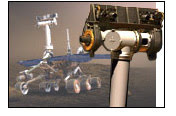WATERLOO, Ontario, Jan. 7 -- Three days after landing on Mars, the exploration rover "Spirit" has begun transmitting high-resolution color images of the red planet back to Earth. The CCD image sensor chips, designed by NASA’s Jet Propulsion Laboratory (JPL) in Pasadena, Calif., were made by DALSA Corp., a semiconductor and electronics company that makes digital imaging and wafer foundry products, at its semiconductor wafer production facility in Bromont, Quebec.

ROVING EYE: DALSA-built sensors on the "camera bar" of each rover provide high-quality images for analysis and navigation.
"Spirit" landed Saturday, and its counterpart, "Opportunity," is expected to land on the other side of the Mars in three weeks. NASA reported yesterday that Spirit had captured its first color image of Mars, the highest resolution picture ever taken of another planet. The rovers' task is to explore for clues in rocks and soil about whether the past environments in their landing areas were ever watery and suitable to sustain life.
Spirit's high-resolution "Pancam," which uses the DALSA-manufactured chips, is the most sophisticated color imaging system ever sent to the surface of another planet and is responsible for the colour images Spirit has transmitted to earth. The stereo pair of CCD cameras is located on a "camera bar" that sits on top of the mast of the rover and is responsible for taking high-resolution views of the surface and sky through eight different coloured filters. Pancam's mast assembly allows it to rotate a complete 360 degrees, while the camera bar itself can swing up or down through 180 degrees of elevation. This allows the cameras to generate stunning panoramic image mosaics as large as 4,000 pixels high by 24,000 pixels around, equivalent to a 96 megapixel image.
The space-qualified chips are critical components in the nine electronic cameras aboard each of the two rovers. Three cameras on each rover are responsible for scientific investigation, including panoramic and stereoscopic images. Six other cameras aid in navigating the vehicle on the surface of Mars.
DALSA engineers in Waterloo also supplied the space-qualified CCD camera electronics for the Canadarm2 robotic arm that was installed at the International Space Station in April 2001.
For more information, visit: www.dalsa.com